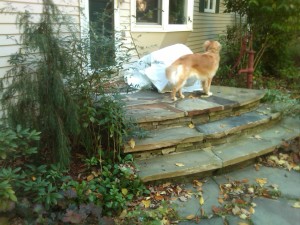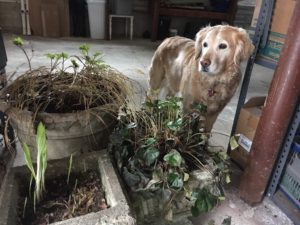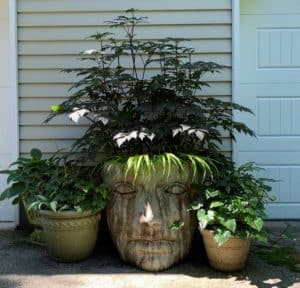Hello, fellow lovers of all things green,
Typically, my garden ghost routine of covering pots with sheets to keep them from freezing begins in late October. Then, I grow weary of the ritual. Besides, one must accept endings. Now, after migrating from annuals in pots to perennials, there are fewer garden ghosts. It’s easier to accept that the growing season is over when your plants return next year. Plus, perennials and small shrubs kick potted gardens up a notch, though potted gardens require overwintering.
How to Overwinter Potted Perennials or Shrubs
Concrete, glazed, or terracotta pots with or without plants will crack if left out in the winter, except for the fancy schmancy (expensive) ones made to withstand old man winter. Generally, fiberglass, polyethylene, or structural foam pots can remain outside.

Miss Ellie is staring at the Garden Ghosts.
While these pots are insulating, even plants suitable in your zone will suffer from the freezing and thawing of roots if unprotected. Some say that two zones hardier (zone 3 plants in zone 5, for instance) may overwinter fine. Still, plants can quickly die if water accumulates and freezes, so be sure the insulated pots drain well.

Learn about my Unexpected Furry Messenger
You can plant the pots themselves (if freeze tolerant) in a holding spot dug in the soil to the top of the pot until the following spring. Or gather them against the north or east side of your home and cover them with a foot of shredded leaves or straw.
Containers moved into an unheated building, such as a garage or shed where temperatures remain slightly above freezing, are ideal, especially for breakable terracotta.
Roots must never dry out.
Regardless of your technique, roots must never dry out, so keep plants moist until the first hard freeze and check the soil whenever the temperature rises above 40°F. Lastly, allowing your plants to go dormant is essential before putting them in their overwintering spots. So maybe garden ghosts aren’t so silly after all.
The pots in the garage during winter cause a bit of stress for Curt as they impede access between the garage bays. And so, he likely wishes the Happy Ending to Naked Pots never came to be.
What fun to peruse a favorite nursery, finding the ‘Mini Penny’ mophead hydrangea (Hydrangea macrophylla) to serve as the anchor piece. However, she was blooming pink rather than blue due to the alkaline soil versus acidic.
I am not a fan of pink; a side effect of childhood enduring walls the shade of Pink Panther, thanks to dear sis whose seniority gave her the color choice. The warm, earthy green I campaigned for would have been more soothing. Who doesn’t like green? It’s the primary color of our dear earth, after all.

Mother Earth face – a gift from dear clients Judy & Hector
A Happy Ending to Naked Pots
So, I chose a perennial option as the anchor plant, grabbing three ‘Brunette’ Snakeroot, Actaea ramosa, aka Cimicifuga simplex, with dark purple foliage. They grow four feet tall with bottle brush white flowers with a tinge of pink in early fall. Yes, Sis, a hint of pink is okay. One must remain flexible.
Sugar & Spice Foam Flower, Tiarella, with bright green deeply lobed leaves and dark burgundy centers, complements the snakeroot. She, too, forms spikes of pinkish-white flowers in spring above her foot-tall foliage.
The shiny heart-shaped leaves of Beesia, Beesia deltophylla, from the Dan Hinkley Collection called my name. Dan Hinkley is a legendary American plantsman known for collecting and propagating unusual plants. Beesia is best in Zone 6 to 8, pushing the envelope in Zone 5b. But next to the garage affords a microclimate for this semi-evergreen woodland plant that grows 18 to 24 inches tall.
Then I topped off the selections with Hakonechloa macra “All Gold’– a variety of Japanese Forest Grass with bright golden-yellow foliage. They grew into bangs on my adored Mother Earth Face Pot gifted to me by dear clients.
All the selections have good deer resistance and will spread over time when I move them from the pots into the woodland garden. But I’ve been enjoying the happy ending for a handful of years as I keep moving them in and out of the garage, bringing happy new beginnings when new growth emerges each spring.
Garden Dilemmas? AskMaryStone@gmail.com and your favorite Podcast App.
There’s more to the story in the Garden Dilemmas Podcast:
Link to Related Story – Filling Late-Season Naked Pots


